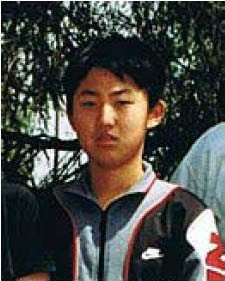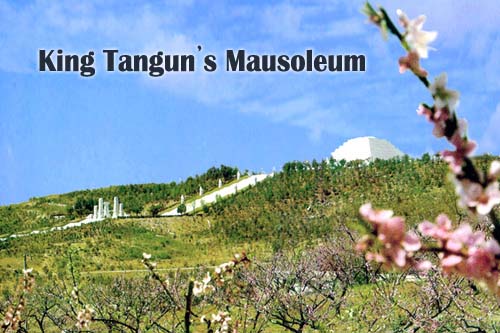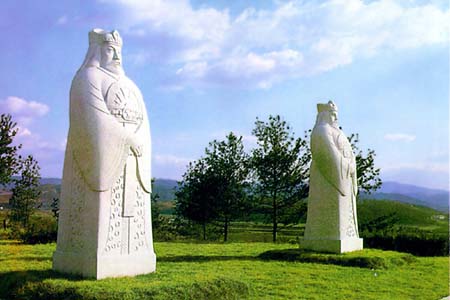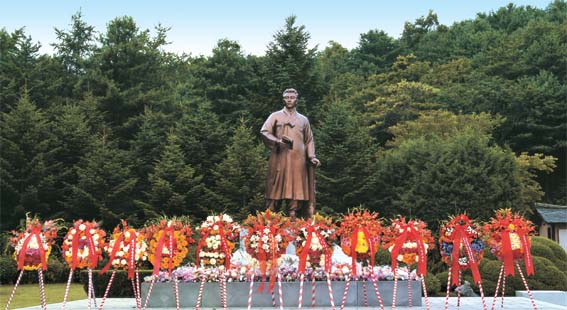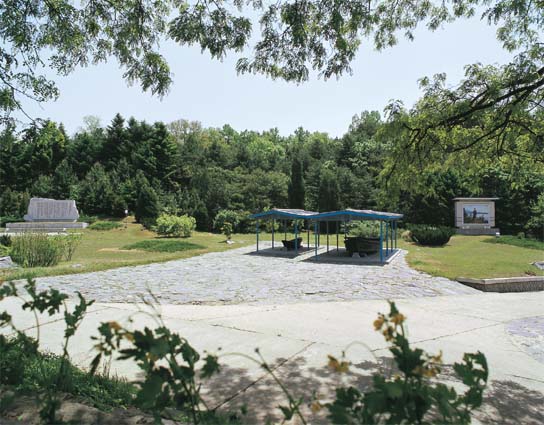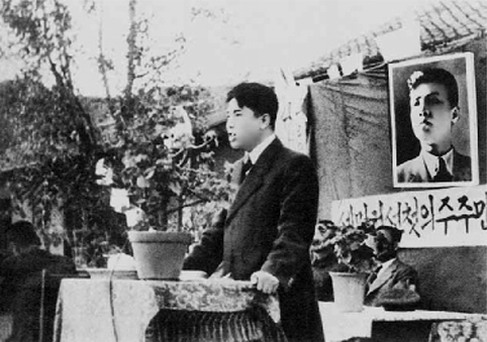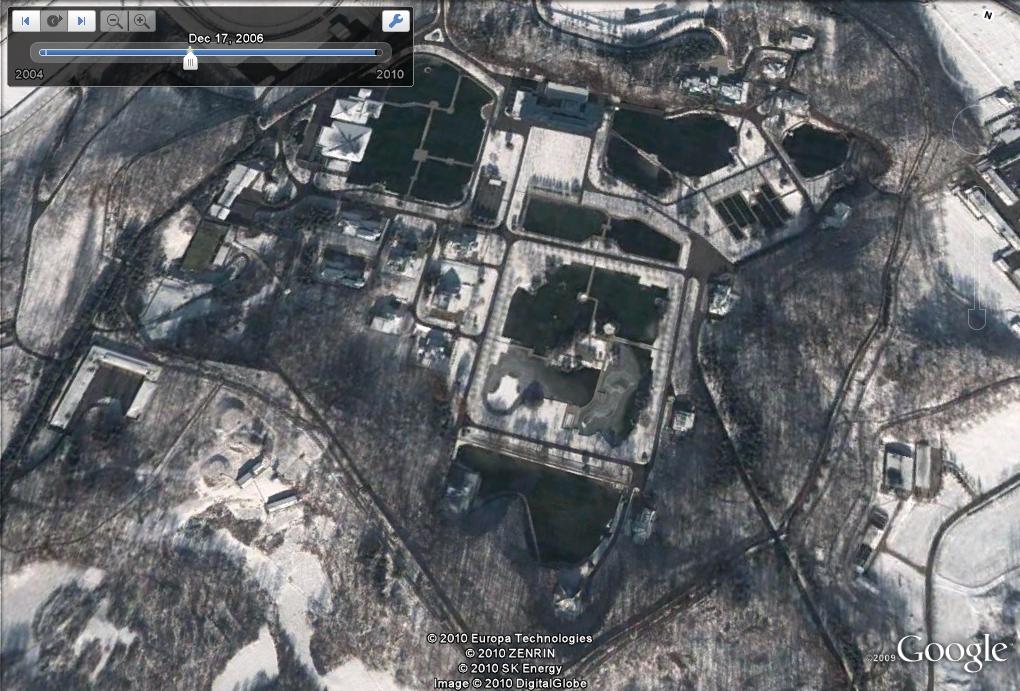Scuttle Buttin’ Jong Un’s Shrine in Kangdong County
The latest Kim Jong Un [Jong-un; Chong-un; Jong Eun] rumor is that the Central Party has ordered the construction of a KJU-related historic site, or “shrine” in Kangdong County. According to Lee Young-hwa, of Rescue North Korean People Urgent Action, a railway extension to the site commenced construction in March, 2009. Work temporarily ceased during the summer of 2009, but resumed in early July of this year. It should be noted that there are railway lines that run through Kangdong, so it would seem an extension to an existing route is what they are constructing.
It is not clear on what site the Jong Un shrine is being developed. It seems the effort to construct a site for Kim Jong Un is part of his official biography, which may claim Kangdong County as a place where he spent his childhood.
The North Korean regime is building a kind of shrine in honor of leader Kim Jong-il’s son and heir apparent Jong-un in Pyongyang, according to a Tokyo-based North Korea activist group. Lee Young-hwa of Rescue North Korean People Urgent Action Network made the claim Thursday.
Lee told the Chosun Ilbo the regime started laying down railway tracks between central Pyongyang and the city’s Kangdong district in March last year. It halted the work last summer but resumed it this month, while also building what will be billed as the “birth house” of Kim Jong-un.
“This is information we’ve obtained from a helper of ours in the North. We believe it’s almost certainly true,” he said.
“The regime is making out that Jong-un’s first hometown is Kangdong and his second one Wonsan,” he said. “But we don’t know if he was actually born in Kangdong.” Ko Young-hee, his mother, arrived at Wonsan from Japan in the early 1960s.
Kangdong is where the regime claims it discovered the ancient burial site of Dangun, the legendary founder of the first Korean kingdom in 2333 BC, and where it set up a statue of nation founder Kim Il-sung’s father Kim Hyong-jik. Because of this, there is speculation that the regime is building Jong-un’s birth house there to highlight that he is carrying on the “revolutionary tradition.”
The Daily NK, a Seoul-based online newspaper focusing on issues relating to the North, reported a similar story at a seminar in Tokyo on May 13 based on interviews with Pyongyang residents.
Kangdong County is the Silicon Valley of the country’s military defense industry, the locale of the main offices of the Second Economic Committee and its dozen, or so, subordinate bureaus. It is northeast of Pyongyang’s city centre and part of the capital city. Originally in South Pyongan Province, Kangdong administrative units were integrated into Pyongyang in October, 1960. In March 1983, the remaining administrative units were integrated into Pyongyang, and Kangdong County became one of Pyongyang’s four (4) suburban counties (kun/gun) located south and east of the city proper[N.B.: as of 18 July 2010 all three counties BUT Kangdong were part of North Hwanghae Province]. Kangdong has always enjoyed a certain historic and cultural significance in regime lore.
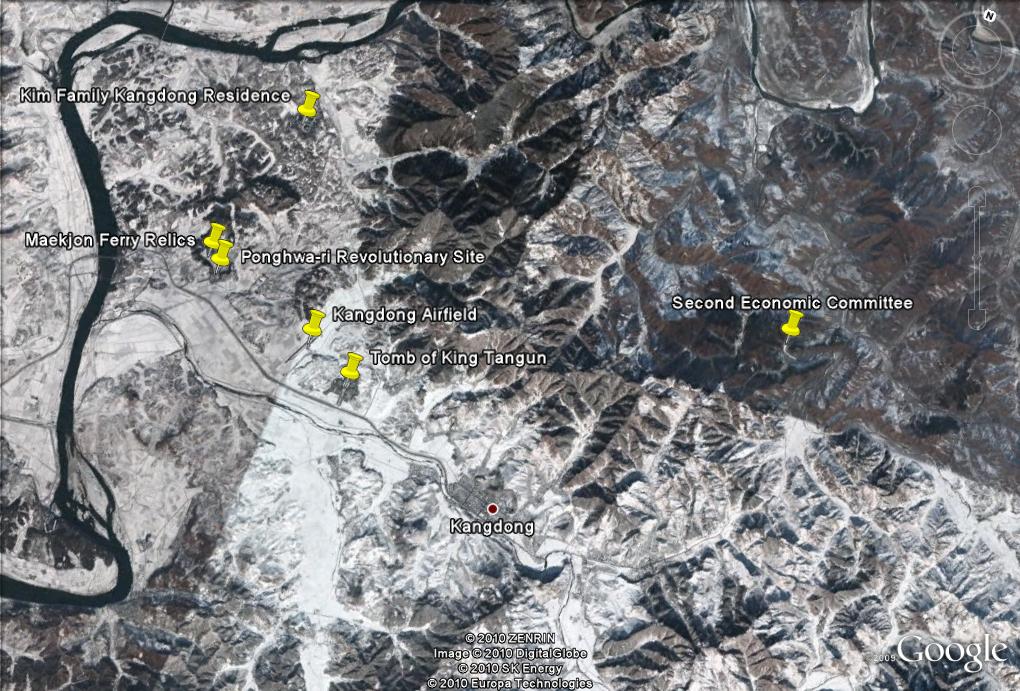
A general overview of Kangdong County, east of the Taedong River, southwest of Songchon County (S Pyongan) and north of Sungho District (Pyongyang) (Google Earth)
Despite whatever mythology PAD is currently concocting, Kim Jong Un did spent a good deal of time at Kim Jong Il’s residential complex located not far from the Taedong River. Kangdong County has certain significance in the lives of the Kim Family. Kim Hyong Jik, father of Kim Il Sung, reportedly lived and worked in Ponghwa-ri, in 1916. The late DPRK President wrote of his time living in Kangdong County in his memoirs:
“When I was young our family lived in Ponghwa-ri. I think I was five years old when we moved there. So I do not fully remember what happened in those days. But I do remember that my family traveled from Mangyongdae to the Maekjon ferry in a boat.
I think the boat was sailing up to Sunchon. My family reached Ponghwa-ri at dusk. At first my family did not lodge in this house. We stayed for several days in another house before moving to our own house.”“Ponghwa-ri is a good place in which to live. When we lived there it was very quiet around the house. It was only when pupils gathered that it became lively. The children of the village would meet there. The people of Ponghwa-ri accepted my father’s instructions with respect and carried them out.
When I lived in Ponghwa-ri, I climbed Mt. Ponghwa once or twice a year and often went up the hill behind Myongsin School and picked and ate the fruit of the wild jujube trees.”“There were many wild jujube trees on the hills around Ponghwa-ri. Wild jujube is tasty. In autumn I used to pick wild jujubes and send them by boat to my grandparents in Mangyongdae.”
“During my childhood I helped Mother in her work in many ways. There was no daughter in my family, so I acted as daughter in Mangyongdae and in Kangdong. I would get up early in the morning and fetch water and take it to Father so he could wash. When Mother prepared the meals I sometimes stewed the bean-curd. My parents ate with relish the bean-curd I stewed.”
“An address one makes before people in one’s childhood remains long in one’s memory. Once I delivered an address at a commemorative meeting in Kangdong, as the Children’s Union’s congratulating groups do now, by learning by heart a speech prepared by my father. I still remember it vividly.”
“My father was teaching Korean to the children at Myongsin School in the autumn 1917 when he was arrested by the Japanese police. The people of Ponghwa-ri prayed for my father’s release for as long as a month . …
Ponghwa-ri was a good place for the anti-Japanese revolutionary fighters to conduct their revolutionary activities, out of sight of the Japanese police.
At the foot of the hill behind Myongsin School I played at soldiers, riding a rock which resembled a horse.”“… When we went to Kangdong after Father, we together with my great-grandmother, went in a boat. At that time my home was a three-roomed house with a back door opening towards a hill, and some distance up the hill was a rock.
I remember that many people in turumagi (Korean overcoat) and straw hat called at my house.
When they called at my house, they usually went up the hill for a talk . … Sometimes my mother and I would burn documents. We burned bundles of documents and the photographs among them.”“Father was arrested in Kangdong when I was five years old. On hearing of this Mother and I burned some documents in the kitchen, when the policemen came. They immediately began to search the house. My mother got so angry that she shouted at them, challenging them to search.
The regime constructed a historic revolutionary site, and erected a statue to KIS’ father. Kangdong County is also home to the Mausoleum of King Tangun. The DPRK claimed to have excavated the tombs of the mythic Korean monarch. The tomb was reconstructed, and the country has used it as a setting for political events. North Korean citizens and foreign tourists are also taken to visit what the DPRK claims is the skeleton and tomb of Tangun.
Kangdong County was also the setting for the Kangdong Political Institute. While it only lasted a few years (1947-1950), the Kangdong Institute was responsible for training operatives to incite revolution in the ROK, pre-Korean (Victorious Fatherland Liberation) War. Kim Il Sung and Kim Jong Suk visited Kangdong on several occasions (in the early days of the DPRK) retail politicking for the regime.
So, the Morningstar General grew up in the ‘burbs. This is not the only Young Captain scuttle buttin’ goin’ on this week. Hankyoreh reports that University of Georgia professor, Park Han-shik, who returned from the DPRK on 8 July, says that Kim Jong Un “seems likely to emphasize ‘economic power.’” Professor Park also labels rumors about KJI’s health and political stability, “the imaginings of the outside of the world.”
“Kim Jong-un could become a figure like China’s Deng Xiaoping.”
These words reflected the sentiment of Park Han-shik, professor of the University of Georgia, during a visit to South Korea that followed a trip to North Korea from July 3 to 8. Park predicts that like Deng, the architect of China’s reform and openness policy, Kim Jong-un, third son and reported successor of Kim Jong-il, could be someone to lead changes in North Korea.
During an interview with the Hankyoreh at the Lotte Hotel in Seoul’s Sogong neighborhood, Park said that Kim Jong-un is expected to assume a major party role at the Party Representatives’ Assembly.
“He seems likely to emphasize building ‘economic power,’” Park said. “North Korea’s domestic policy of late seems to be rather tilted toward economic development.”
Park also reported going to the electronic library at Kim Il Sung University and seeing a handwritten message from Kim Jong-il reading, “Set foot on my land and see the world.” Park said that he sensed North Korea’s interest in the outside world and its determination to engage in interchange.
Regarding speculation in South Korea, the United States and Japan about Kim Jong-il’s ill health and the possibility of a sudden upheaval in North Korea, Park called this “purely the imaginings of the outside world.”
“Based on what I observed, North Koreans are not frightened about political stability and power succession issues,” Park said. “Instead, there is a lot of interest in cultivating the economy.”
He also noted that there was much speculation about a possible crisis, such as a North Korean collapse, when the Kim Jong-il regime began in 1994, but responded, “It has now been sixteen years and nothing has happened.”
